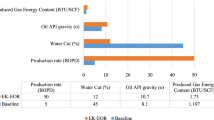Abstract
The direction of oil charges within a field in the Niger Delta, Nigeria was determined by the sum of differences ranking method of carbazole concentrations after ascertaining other possible geological constraints on their compositional variations. The principle is that the smaller the sum, the closer the well to the source kitchen. The approach makes use of carbazoles’ interaction with the matrix, which leads to a reduction in their concentration with increasing distance from the source kitchen, allowing prediction of the charging direction. A wide range of compositional variations was observed for C1 (806.72–2152.90 μg/g) and C2 (767–2469.72 μg/g) carbazoles within the field. Based on these results, we inferred a filling pathway orientation from west to east. This suggests that the source kitchen—the most promising region for oil exploration—is located in the western part of the oil field.












Similar content being viewed by others
References
Bakr MMY, Wilkes H (2002) The influence of facies and depositional environment on the occurrence and distribution of carbazoles and benzocarbazoles in crude oils: a case study from the Gulf of Suez, Egypt. Org Geochem 33:561–580
Clegg H, Wilkes H, Oldenburg T, Santamaria-Orozco D, Horsfield B (1998) Influence of maturity on carbazole and benzocarbazole distributions in crude oils and source rocks from the Sonda de Campeche, Gulf of Mexico. In: Horsfield B, Radke M, Schaefer RG, Wilkes H (eds) Advances in organic geochemistry, vol 29. Elsevier, Oxford, pp 183–194
Duan Y, Yuan Y, Qian R (2013) Migration features of crude oil in fluvial deposits of Maling oilfield in Ordos Basin, China. Org Geochem 58:78–85
Ekweozor CM, Daukoru CM (1994) Northern delta depobelt portion of the Akata-Agbada(!) petroleum system, Niger Delta, Nigeria, in the petroleum system—from source to trap. Am Assoc Pet Geol Mem 60:599–613
Faboya OL, Sonibare OO, Liao Z, Ekundayo O, Tian Y (2014) Occurrence and distribution of carbazoles and benzocarbazoles in Tertiary Niger delta source rocks. Pet Sci Technol 32:2938–2952
Huang H, Bowler BFJ, Zhang Z, Oldenburg TBP, Larter SR (2003) Influence of biodegradation on carbazole and benzocarbazole distributions in oil columns from the Liaohe basin, NE China. Org Geochem 34:951–969
Hwang RJ, Heidrick T, Mertani B, Qivayanti Li M (2002) Correlation and migration studies of North Central Sumatra oils. Org Geochem 33:1361–1379
Larter SR, Bowler BFJ, Li M, Chen M, Brincat D, Bennett B, Noke K, Donohoe P, Simmons D, Kohnen M, Allan J, Telnaes N, Horstad I (1996) Molecular indicators of secondary oil migration distances. Nature 383:593–597
Li M, Larter SR, Stoddart D, Bjoroy M (1995) Fractionation of pyrrolic nitrogen compounds in petroleum during migration: derivation of migration-related geochemical parameters. In: Cubitt JM, England WA (eds) The geochemistry of reservoirs. Geological Society, London, pp 103–123
Li M, Wang TG, Shengbao S, Keyu L, Geoffrey SE (2014) Benzo[b]napththiophenes and alkyl dibenzothiophenes: molecular tracers for oil migration distances. Mar Pet Geol 57:403–417
Mackenzie AS (1984) Applications of biological markers in petroleum geochemistry. In: Brooks J, Welte DH (eds) Advances in petroleum geochemistry, vol 1. Academic Press, London, pp 115–214
Mango FC (1994) The origin of light hydrocarbons in petroleum: ring preference in the closure of carbocyclic rings. Geochim Cosmochim Acta 58(2):895–901
Peters KE, Moldowan JM (1993) The biomarker guide. Interpreting molecular fossils in petroleum and ancient sediments. Prentice-Hall, Englewood Cliffs, pp 103–114
Peters KE, Watters CC, Moldowan JW (2005) The biomarker guide. Cambridge University Press, Cambridge UK
Radke M, Welte DH (1983) The Methylphenanthrene Index (MPI): a maturity parameter based on aromatic hydrocarbons. In: Bjorøy M (ed) Advances in organic geochemistry 1981. Wiley, New York, pp 504–512
Short KC, Stauble AJ (1967) Outline of geology of Niger Delta. Assoc Pet Geol Bull Mem 51:761–779
Terken JMJ, Frewin NL (2000) The Dhahaban petroleum system of Oman. AAPG Bull 84:523–544
Yang Y, Arouri K (2016) A simple geotracer compositional correlation analysis reveals oil charge and migration pathways. Sci Rep 6:23066. https://doi.org/10.1038/srep23066
Yang YL, Aplin AC, Larter SR (2005) Mathematical models of the distribution of geotracers during oil migration and accumulation. Pet Geosci 11:67–78
Zhang S, Handson AD, Moldowan JM, Graham SA, Liang D, Chang E, Faga F (2000) Paleozoic oil-source rock correlations in the Tarim Basin, NW China. Org Geochem 31:273–286
Zhang C, Zhang Y, Cai C (2011) Maturity effect on carbazole distributions in source rocks from the saline lacustrine settings, the western Qaidam Basin, NW China. J Asian Earth Sci 42:1288–1296
Acknowledgements
The authors deeply appreciate the Third World Academy of Sciences and Chinese Academy of Sciences for providing the first author (OLF) a postgraduate fellowship toward this research work.
Author information
Authors and Affiliations
Corresponding author
Ethics declarations
Conflict of interest
The authors declare that they have no conflict of interest.
Rights and permissions
About this article
Cite this article
Faboya, O.L., Sonibare, O.O., Faboya, O.T. et al. Data modelling for crude oil migration studies using ranking method: a rapid geo-tracer technique for geochemists. Acta Geochim 37, 901–910 (2018). https://doi.org/10.1007/s11631-018-0264-9
Received:
Revised:
Accepted:
Published:
Issue Date:
DOI: https://doi.org/10.1007/s11631-018-0264-9




